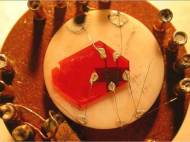Rutgers University research could lead to more efficient plastic solar cells
 Physicists at Rutgers University have discovered that energy-carrying particles generated by packets of light can travel on the order of a thousand times farther in organic (carbon-based) semiconductors than scientists previously observed. This boosts scientists’ hopes that less expensive plastic solar cells based on this budding technology may one day overtake silicon solar cells in cost and performance.
Physicists at Rutgers University have discovered that energy-carrying particles generated by packets of light can travel on the order of a thousand times farther in organic (carbon-based) semiconductors than scientists previously observed. This boosts scientists’ hopes that less expensive plastic solar cells based on this budding technology may one day overtake silicon solar cells in cost and performance.
“Organic semiconductors are promising for solar cells and other uses, such as video displays, because they can be fabricated in large plastic sheets”, said Vitaly Podzorov, assistant professor of Physics at Rutgers. “But their limited photo-voltaic conversion efficiency has held them back. We expect our discovery to stimulate further development and progress.”
Podzorov and his colleagues observed that excitons can travel a thousand times farther in an extremely pure crystal organic semiconductor called rubrene. Until now, excitons were typically observed to travel less than 20 nanometers in organic semiconductors. Excitons are particle-like entities consisting of an electron and an electron hole (a positive charge attributed to the absence of an electron). They can generate a photo-voltage when they hit a semiconductor boundary or junction, and the electrons move to one side and the holes move to the other side of the junction. If excitons diffuse only tens of nanometers, only those closest to the junctions or boundaries generate photo-voltage. This accounts for the low electrical conversion efficiencies in today’s organic solar cells.
“This is the first time we observed excitons migrating a few microns”, said Podzorov, noting that they measured diffusion lengths from two to eight micrometers. This is similar to exciton diffusion in inorganic solar cell materials such as silicon and gallium arsenide.
While the extremely pure rubrene crystals fabricated by the Rutgers physicists are suitable only for laboratory research at this time, the research shows that the exciton diffusion bottleneck is not an intrinsic limitation of organic semiconductors. Continuing development could result in more efficient and manufacturable materials.
The scientists discovered that excitons in their rubrene crystals behaved more like the excitons observed in inorganic crystals – a delocalized form known as Wannier-Mott (WM) excitons. Scientists previously believed that only the more localized form of excitons, called Frenkel excitons, were present in organic semiconductors. WM excitons move more rapidly through crystal lattices, resulting in better opto-electronic properties.
Podzorov noted that the research also produced a new methodology of measuring excitons based on optical spectroscopy. Since excitons are not charged, they are hard to measure using conventional methods. The researchers developed a technique called polarization resolved photocurrent spectroscopy, which dissociates excitons at the crystal’s surface and reveals a large photocurrent.
The technique should be applicable to other materials, Podzorov claims. For more information read the paper published in Nature Materials named: “Observation of long-range exciton diffusion in highly ordered organic semiconductors”.









Good research in solar cell area by Rutgers University and it may lead to affordable solar cells.
Dr.A.Jagadeesh Nellore(AP),India